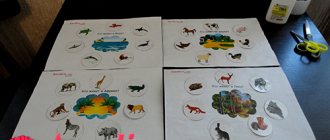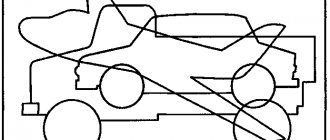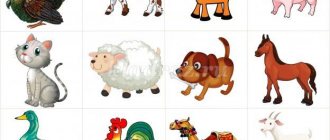If you think that your child is not yet old enough to master the basics of mathematics, then you are deeply mistaken. Various early development methods and a variety of didactic materials not only contribute to the development of mathematical abilities in children, but also instill in them a love for the “queen of the exact sciences.” One of these methods is the development of George Cuisenaire, who forced us to take a fresh look at the counting sticks that are well known to us.
If you think that your child is not yet old enough to master the basics of mathematics, then you are deeply mistaken. Various early development methods and a variety of didactic materials not only contribute to the development of mathematical abilities in children, but also instill in them a love for the “queen of the exact sciences.” One of these methods is the development of George Cuisenaire, who forced us to take a fresh look at the counting sticks that are well known to us.
It is noteworthy that George Cuisenaire managed to create multifunctional didactic material that allows not only to teach children mathematics, but also has a positive impact on the development of fine motor skills, memory, attention, perseverance, visual-effective thinking, imagination, design and combinatorial abilities. At the same time, Cuisenaire sticks can be used both as an independent teaching tool and as additional material to the main early development method.
A few words about George Cuisenaire
Belgian teacher George Cuisenaire is the author of a unique method of early childhood development, having worked in school almost his entire life. Working as a simple teacher in primary school allowed Cuisenaire to put into practice various methods and teaching programs, compare them and “adopt” the most effective and efficient ones. He refined some of the techniques based on his own experience, and described the result in detail in his practical recommendations for teaching children music, geography, art and biology.
Cuisenaire sticks, now famous throughout the world, are also the result of careful refinement. Using the method of his German colleague Friedrich Froebel when teaching children mathematics, Cuisener noted the interest of children and, as a result, the high effectiveness of this method. Froebel's findings formed the basis of Cuisenaire's own method, which was called “Color Numbers.”
Games with Cuisenaire sticks for children from 5 to 9 years old
For older children, such aids as:
- A set of games “On the Golden Porch” for children from 3 to 9 years old.
- Set of games “China shop. Krostiki" for children from 5 to 8 years old.
With the help of these kits, children will easily get acquainted with the principle of coloring sticks, with the relationships of color - length - number; will be able to recognize a pattern and lay out sticks in accordance with it; will be able to lay out (reproduce) an object along its contour, master the operations of “decoding” images; get acquainted with symmetry; learn to navigate on a plane and work with a coordinate system.
- Once upon a time there were colorful sticks. They were in a tight box. And then one day, when all the sticks were poured out of the box, they decided to build themselves colorful houses and live there as families.
- Anya, let's cast a spell on the little kitten and put it out of sticks.
Interesting cards are cards with tasks that allow you to independently lay out an image according to a diagram.
Tasks of increased complexity include cards with image content encoded in numbers. The young player needs to “decode” this image and build it using sticks.
An excellent tool is the mathematical game “China Shop. Krostiki" for children from 5 to 8 years old. In this manual, children are offered tasks to design in a coordinate system. At first, completing tasks of this level of complexity was too much for even my eldest 8-year-old daughter Masha.
Features of the Cuisenaire technique
The classic set of Cuisenaire sticks consists of ten prism sticks ranging from 1 to 10 centimeters in length: the larger the stick, the greater the number value it displays. The colors of the sticks were also not chosen by chance. For example, the numbers of the “red” group of sticks (red, pink and burgundy colors) are multiples of two (2, 4 and 8 centimeters). There are three “blue” groups (blue, cyan and violet colors), and five “yellow” ones. By highlighting the color and length of the sticks, the child begins to understand during the process of manipulation that the number is the result of counting and measurement.
In addition, the volume of the sticks and their identification by color and length allows the baby to master sensory standards (size and color), as well as ways of recognizing and comparing objects by width, height and length. Using Cuisenaire's counting sticks, it is very easy to bring a child to the awareness of such relationships as long-short, right-left, more-less, same-different, high-low, etc.
The main distinctive feature of Cuisenaire colored numbers is that the child masters the simplest mathematical concepts in a playful way.
This means that he will associate mathematics with a fun and exciting activity, allowing him to show his imagination and creativity. Note that the author himself recommended starting classes using his method with children aged 1 year. At the same time, he emphasized more than once (and practice has proven this) that his development will be equally interesting for both children aged 1-2 years and schoolchildren aged 8-9 years.
Games with Cuisenaire sticks for children from 2 to 3 years old
For games with kids, the following aids are ideal:
- Album-game “It's fun to play together” for children from 2 to 3 years old.
- Album-game “Magic paths for the little ones” (from 2 to 3 years old).
Kids will be able to lay out simple images using sticks, as well as get acquainted with basic colors and concepts such as “one - many”, “high - low”.
- Anya, look who came to visit us today. So this is a real centipede. A centipede hurries along the blue path. And to make it convenient for her to crawl, let’s build her a path out of sticks.
- Anya, our mouse friends are in trouble. The cunning cat Vaska is hunting for them. Let's quickly hide the mice in the houses. To do this, we will close the houses with our miracle wands, and the evil cat Vaska will not be able to find the mice. Close the windows quickly - you will save the mice from the cat.
How are classes conducted using the Cuisenaire method?
Classes using the Cuisenaire method can be divided into two stages:
- play - sticks are used as material for games (the baby plays with them as with the most ordinary cubes or mosaics: builds ladders or lays out figures). During the game, the child develops visual perception and fine motor skills. By commenting on the child's games, adults help him become familiar with the colors and sizes of sticks.
- educational - act as a universal mathematical aid that allows a child to form the concept of a numerical sequence and the composition of a number “through the hands” (that is, visually). The choice of exercises using Cuisenaire counting sticks
is carried out taking into account the level of development and capabilities of children, as well as their interest in solving certain problems. For example, for younger children, you can offer tasks in the form of game motivation (fix a fence, build a ladder, etc.). For older children, you can choose tasks in the form of competitions (who can build a labyrinth faster, find the right number, etc.).
Classes using the Cuisenaire method are greatly facilitated by special manuals with bright drawings and diagrams designed for different age categories of children, which can be found in almost any store specializing in the sale of educational games.
Preparatory group. Senior preschool age. Children 6-7 years old
Summary of GCD for FEMP in the preparatory group using Cuisenaire sticks “Journey through the seasons” Summary of GCD for FEMP in the preparatory group using Cuisenaire sticks “Journey through the seasons”
Goal: developing interest in the subject of mathematics, based on cognitive activity and curiosity. Objectives: Educational: — To consolidate children’s knowledge about the seasons,…
Summary of GCD using Cuisenaire sticks for children 5–6 years old “Such different flowers”
“Such different flowers”
Target.
Development of children's ability to work with Cuisineer sticks . Tasks. Teach children to model according to verbal instructions; correlate the size of objects; navigate on a plane; lay out the drawing according to the sample. Practice the ability to see a pattern and...
Disadvantages of the Cuisenaire technique
Almost all experts unanimously claim that Cuisenaire sticks have no disadvantages. Today, this didactic material is one of the best and most effective tools for introducing children to mathematics from a very early age. The opinion of experts is also confirmed by numerous enthusiastic reviews from parents who are already practicing the Cuisenaire method at home.
But, as you know, even in honey you can find a fly in the ointment. “Colored numbers” were no exception. The proverbial “fly in the ointment” can be considered the need for systematic joint (parents and children) activities with counting sticks. Otherwise, the effect will be practically unnoticeable.
Subscribe to our Telegram to stay up to date with important news in the field of education.
Cuisenaire's rods: what are they?
Cuisenaire's technique is aimed at using the principle of clarity. Concepts from the field of mathematics that are difficult for children - numbers, quantities, relationships between them - are presented in a form that is as accessible as possible. This helps teach your child the steps necessary to reinforce simple but important math concepts.
Cuisenaire sticks:
- Helps develop visual and figurative thinking.
- They will teach you to see the similarities and differences of objects, compare, contrast.
- The ability to divide a whole into separate parts, or to measure an object with another, similar to it.
- The existence of a set of elementary arithmetic operations, paired and inverse to each other: addition - subtraction, perhaps even multiplication - division.
- The meaning of complex comparative concepts such as “to the left or to the right”, “longer or shorter”, “between”, “each”, “any”, “objects of the same color”, “objects not blue”, “objects of equal length "
Children have a desire to master the skills of working with counting, with the number system, and measurements.
Cuisenaire rods: description of the methodology, history and purpose of creating counting exercises
In 1952, a mathematical manual for preschoolers and primary schoolchildren was published. It was created by the Belgian mathematician George Cuisenaire. During learning, a child uses all his senses, so the method is based on the tactile mastery of some mathematical abstract concepts - orderliness, set, identity.
A colleague of the Belgian mathematician, the French scientist and philosopher Caleb Gateno, made this manual popular and for the first time began using colored counting sticks to teach children mathematics and various languages. A child, mastering one science, simultaneously develops other abilities. He will be able to identify logical connections in speculative concepts, learn to use imagination and abstract thinking.
The Cuisenaire rod technique has several goals:
- The child develops a specific counting system;
- the concept of larger and smaller numbers develops;
- skills of addition and subtraction, multiplication and division appear;
- children distinguish between the right and left sides, learn to determine the middle;
- creativity, creative inclinations, modeling and design skills develop;
- cognitive character, visual and effective methods of thinking are manifested, all types of attention are sharpened, the environment is perceived in more detail;
- fine motor skills of the hands improve.
The age for starting classes is determined individually, it depends on the development of the child. But usually the first lessons are given to three-year-old children. Although some teachers advise developing them from the age of one, teaching them to solve mathematical problems with colored sticks.
Making your own counting sticks
The set contains parallelepipeds ranging in size from 10 to 1 cm; they differ in color and material from which they are made. There are also instructions for colored Cuisenaire counting sticks, templates for different numbers and a manual with recommendations and a list of steps, tasks and examples. The lengths of the bars indicate numbers, and the colors indicate their classes.
The longer the stick, the larger the number; each centimeter adds one. Groups and classes are divided by shade: red - numbers that are multiples of two, green and blue are divided by three, units are indicated by white, and divisible by 5 and 10 - orange and yellow. The classic collection contains 241 sticks, but for preschoolers they produce simplified sets of 119 or 144 blocks. In some models, green is replaced by blue or purple, and red by pink.
Parents do not have to purchase a ready-made set; they can make it themselves. Sticks are made from wooden blocks or colored cardboard. The first option will allow the child to navigate not only by the shades and length of the product, but also by its volume. On the Internet you can find a table of the sizes of each block, as well as stencils and templates. They are printed and used to cut out sticks from the selected material. Wooden sticks are coated with a layer of acrylic paint in a tone corresponding to the class of numbers.
It is advisable to write numbers on cardboard products, so children will remember them faster. If classes are conducted using a magnetic board, then small magnets are also attached to the back of the blocks. Pre-prepare a box for storage. It should have different sections for each color of stick. After lessons, the child will independently arrange the blocks into the appropriate cells. This will help develop self-discipline and teach your child order.
Summary of GCD using Cuisenaire rods in the younger group of kindergarten. Count within 3
The use of fairy tales (fairy tale characters) in the development and education of children.
Summary of GCD using Cuisenaire sticks based on the fairy tale “The Three Bears” for children of the younger group of kindergarten. Description: This lesson based on the fairy tale “The Three Bears” using Cuisenaire sticks will contribute to the development of elementary mathematical concepts in preschoolers 3-4 years old (counting within 3, fixing the names of colors, distinguishing sizes). The material may be useful to kindergarten teachers, special education teachers, and parents. Goal : formation of elementary mathematical concepts in children with learning difficulties Objectives: - Develop curiosity and cognitive activity when getting acquainted with fairy tales - Develop children's speech, expand vocabulary - Strengthen counting skills within 3 - Strengthen the names of primary colors, sizes of objects. -Develop visual perception -Develop motor skills Equipment: printouts with tasks for children, pictures of 3 bears and Mashenka, Cuisenaire sticks, and sheets with tasks for them
Progress of the lesson: Teacher: In one magical forest there lived a family of bears. Bear - Papa - Mikhail Ivanovich - the largest bear, mother bear - Nastasya Petrovna - medium in size and the smallest bear - their son Mishutka. (We place pictures of three bears on the desk one by one)
Each of the bears lived in their own house. Papa Bear had the biggest house - like this, (We put a printout with task number one on the desk)
Let's build a house for a big bear from sticks (Children select suitable sticks and put them on the printout) What a beautiful house Mikhail Ivanovich has! The bear is big and so is the house... Children: Big! Teacher: Well done! Mom, Nastasya Petrovna, also had her own house - medium size (we post a printout of task number two)
Let's build a house for the mother bear! (children select suitable sticks) Teacher: What is the size of mother’s house? Children: Average! Teacher: Correct! And Mishutka also had his own house, since he was a small bear, his house was the smallest. (we post a printout with task number 3)
Let's build a house for Mishutka! (Children lay out suitable sticks) Teacher: Well, all the houses are ready, let's plant ours next to their houses. The big bear lives in... Children: Big house Teacher: Correct. (we plant the bear next to the house)
What color sticks were used to build the house? Children: blue! Teacher: Well done. Mother bear lives in... Children:: Middle house Teacher: Well done! (we plant the bear next to the house)
What sticks were used to build the house? Children: from the yellow ones! Teacher: That's right! And Mishutka lives in... Children: in a small house! Built from red sticks! Teacher: Well done!
Near each house there was a Christmas tree (we post pictures of three Christmas trees of different sizes).
Near the big house is the tallest Christmas tree. Near the middle house there is a lower Christmas tree, and near the small one it is the lowest. Let's plant the right Christmas trees next to each house (Children work independently, matching the appropriate size Christmas trees)
Teacher: What kind of Christmas tree grows near dad’s house? Children: Tall Teacher: Near mom’s? Children: Lower Teacher: Near Mishutkin? Children: Lowest Teacher: Correct. Each of the bears had a room with their favorite furniture in the house. In my dad’s house there was this big table and chair (we demonstrate task number 4)
Let's build stick furniture for the big bear. (Children work independently, selecting suitable sticks) Mikhail Ivanovich the bear loved to sit on his big chair (we put the bear on a chair) The mother bear also had her own room, where there was a middle table and a chair (we demonstrate task number 5).
Let's build some furniture for mom out of sticks. (Children work independently, choosing suitable sticks) Great! Mom also really loved her room, sitting on her chair (we put the bear on the chair). Mishutka also had her own room, where there was a small chair and a table (we demonstrate task number 6)
Let's build furniture for Mishutka. (Children work independently, choosing suitable sticks)
Teacher: Each bear had a favorite cup and plate (we show pictures of dishes of different sizes). Let's find the largest dish for dad. (Children select the largest cup and plate and place it on the table)
Teacher: Well done. What color is dad's dishes? Children: Orange Teacher: That's right. Mom had a medium plate and cup, let's find mom's dishes and put them on the table (Children work independently)
Teacher: Well done. What color is mom's dishes? Children: Blue. Teacher: Correct. Well, Mishutka had the smallest plate and cup, let’s put them on the table too. What color are they?
Children: Red. Teacher: Correct! Every day the bears went to the forest clearing to pick berries. Everyone had their own basket, dad had a large one, mom had a medium one, and Teddy Bear had a small one. And so they took baskets and went for berries. When they left, they never locked their houses, because no one lived in the forest except them. At this time, a little girl Mashenka was walking through the forest. (We show a picture or a small doll) She got lost, wandered along the forest paths for a long time, was very tired, and finally came out into the clearing to the bear’s houses. She entered the largest house and saw a room with furniture and a cup on the table. She was very thirsty, she took a cup from the table, but the cup was too heavy; the girl dropped it and the cup broke into small fragments. The girl got scared, ran out of the house and ran into Mishutkin’s little house. She sat down on a chair, but the chair was too small for Mashenka and it broke. The girl got scared, ran out of the house and ran into her mother’s middle house. There she sank weakly onto her mother’s chair and cried bitterly. Meanwhile, the bears collected berries and returned home. Everyone went into their own house. Dad saw that his favorite cup... was broken. Mishutka discovered that his favorite chair was broken. And the mother bear found Mashenka crying bitterly in her house. The bear Nastasya Petrovna called Mikhail Ivanovich and Mishutka and together they began to calm the girl down. Mashenka stopped crying and told them her story - how she got lost in the forest, was very tired, and suddenly saw houses. Mashenka explained that she didn’t want to break anything at all, she just wanted to drink and rest a little. The girl apologized to the bears and promised to fix everything. Let's help Mashenka glue her dad's cup and fix Mishutka's chair (We put a printout with cut-out pictures on the desk, the children assemble it themselves)
Teacher: The bears forgave Mashenka and did not become angry with her. They gave her delicious tea with berries, and then showed her the short way from the forest to the girl’s house. Mashenka thanked them and promised that she would never walk through the forest alone again, only with her mom and dad. This is the end of our fairy tale. Did you like the fairy tale? Children: Yes, I liked it! Teacher: Then finally, let's collect pictures with our heroes. (we put cut-out pictures of the characters on the desk, the children assemble them themselves)
We recommend watching:
GCD on FEMP in the second junior group Summary of organized educational activities on FEMP in the second junior group Synopsis of a frontal lesson on FEMP in the 2nd junior group GCD in mathematics in the 2nd junior group
Similar articles:
Math lesson notes. Theme: “One - many, big - small.” Second junior group
Math lesson notes. Topic: "Circle". Second junior group
Summary of a lesson on FEMP in kindergarten in the second junior group. Topic: “Spatial relations”
Summary of a lesson on FEMP in kindergarten in the second junior group. Triangles
Summary of lessons in kindergarten in the younger group. Topic: “Parts of the day”



